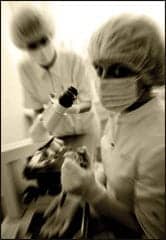Can steps taken to improve quality also improve laboratory productivity? At the Heartland Blood Centers in Aurora, Ill., they have. In fact, borrowing process controls from the manufacturing sector may turn out to be among the most positive changes made by its donor screening centers.

As part of its ongoing efforts to improve, the Heartland Blood Centers implemented a Manufacturing Execution Systems (MES) approach to blood testing. Both the quality and productivity results have been impressive:
- improvements have been realized in both testing reliability and productivity of the virology lab. Initial and secondary reactive rates have declined due to the consistency of an automated plate handling and testing process;
- labor requirements in the lab have been reduced from six FTEs to four, and further improvement is possible. Testing capacity, even with just a single 10-hour shift each day, is estimated at 160,000 units per year, a potential increase over the current workload of 45 percent.
A manufacturing approach to testing
With the promulgation of the FDA’s current Good Manufacturing Practice requirements, the testing of blood for infectious disease markers is evolving into a process that fits the modern definition of pharmaceutical product manufacturing. Standard operation procedures (SOPs) for each step in the process — collection, storage, testing and distribution — are developed and followed. Each step is carefully documented and ideally, procedures are automated to ensure compliance and to remove potential human error.
Although blood centers continue to meet and exceed FDA requirements, a long-term goal of the industry is to meet ISO 9000 standards, just as manufacturers in other industries strive to do in today’s competitive market. ISO 9000 specifies minimum system requirements to ensure that GMPs are followed; as long as operations proceed according to predefined SOPs, quality is assured.
One avenue to ISO 9000 compliance is embracing MES methodology to control laboratory operations. This was the route chosen by Heartland. It started using the Ortho Summit System (OSS) from Ortho-Clinical Diagnostics, to test for HCV version 3.0 Ab, HBcAb, HBsAg, HTLV-I/II Ab, HIV-1/HIV-2 Ab and HIV-1 p24 Ag in July 1999. The system’s software includes predesigned controls and task limits that fulfill sample handling, incubation and reagent dispensing to the exacting requirements of the system’s tests. Robotic hardware and software control and monitor the blood testing process to ensure that it remains within predefined parameters. The system allows technicians to act only when certain testing requirements have been met. It schedules the steps required for processing, and it tracks and documents the process, creating manufacturing batch record documentation for the various assays run by OSS.
Heartland’s OSS improved both the reliability and productivity of its infectious disease testing. It supports microplate tests produced by numerous manufacturers. That means the blood center can choose the best infectious disease ELISA assays available in microplate format.
Utilizing MES
The Manufacturing Execution Systems (MES) methodology was developed by the manufacturing industry to improve production efficiency and quality. It focuses on processes that improve product quality while reducing cycle time, work-in-process, manual paperwork and lead times.

MES concepts are widely used in the manufacture of automobiles, semiconductors, electronics, pharmaceuticals and medical products. The functions most applicable to the donor screening industry are: data collection/acquisition, quality management, operations/detail scheduling, document control, process management and product tracking.
A primary goal of MES in manufacturing environments, and now, in the donor screening center, is to achieve ISO 9000 certification which requires four things:
- an accepted and documented set of procedures
- proof or verification that procedures are followed correctly
- periodic audits of process quality
- corrective action when procedures are not followed.
MES systems provide a model of the manufacturing environment through which an organization can implement the policies and procedures demanded by ISO 9000. MES ensures that manufacturing is performed within specified parameters and that records of both compliance and exceptions are kept. These are key sources of data for demonstrating conformance during audits. Using MES verifies, in real time, all the data associated with a manufacturing operation. It plays a role as both a vehicle for audits and implementation of continuous improvement.
Adapting MES to the Donor Screening Center
According to MESA International, a not-for-profit association providing a forum for competitors to work together to expand awareness and use of new manufacturing technology, the benefits of MES implementation in healthcare manufacturing include cycle time reductions of more than 50 percent and reduction of batch deviations by 90 percent.
Based on the MES model, the Ortho Summit System automates the tasks associated with the testing, evaluation, management and record-keeping of the six viral blood screening assays the FDA requires.
It automates high-volume ELISA microplate testing and delivers optimal specificity and sensitivity. The microplate technology ensures that as the FDA requires additional tests, blood centers will be positioned to add new assays to the system.
Among the critical tasks automated by the system are (1) identification of every sample, plate and reagent; (2) identification of master lots; (3) record-keeping to support user verification of key parameters such as volume, temperature and optical densities; (4) sample management.
These features address all of the requirements described in the FDA’s current Good Manufacturing Practices (cGMP). By automating processes, the system eliminates many opportunities for human error and enables strict adherence to assay procedures. The system also facilitates effective documentation by tracking every step of tests by sample, plate and reagent.
Automation improves user efficiency and cuts labor requirements. Sample incubation, plate washing, reagent dispensing and result reading all are automated by OSS. Results from multiple systems can be routed electronically for central verification and tracking, eliminating the need to manually compare records.
Heartland Blood results
Heartland Blood Centers, a community blood center with two manufacturing facilities in the Chicago area, processes 110,000 units a year, supplying healthcare providers in northern Illinois and northwest Indiana. Our infectious disease lab operates six days a week, with a single, 10-hour shift. We have realized numerous benefits from our OSS implementation.

Implementation of the OSS has brought control to what was previously a manual process. In the past, we had one technician dedicated to each of the six tests performed. That less-than-optimal allocation of resources helped ensure some control in an all-manual testing environment.
Now OSS controls every operation. No step is initiated until the previous step has been completed satisfactorily. Software monitors processes that ensure proper temperature, incubation times and reagent additions. Because our OSS hardware is networked, we can determine the status of a sample by checking any workstation in the lab. We can access a report that details all the testing performed on a sample. This definitely improves upon checking on sample results at multiple assay stations.
Documentation
Documentation is now automated. In the past, with manual testing, the lab used run control sheets for each assay. Technicians documented all operations from the time test kits were taken from the refrigerator to the time the results were sent to the computer. The forms were routinely checked by two people to ensure accuracy before results were transferred to the LIS. Manual documentation of steps alone, however, didn’t necessarily ensure compliance.
Now, the OSS tracks such variables automatically and reports on them. If incubation time or temperature is incorrect, or a wash step isn’t completed, the system will not allow the plate to be tested. It voids the plate. (A future software upgrade will prevent testing if the equipment has not undergone critical maintenance steps.)
Training
Lab training has traditionally involved training an operator in standard lab procedures to ensure safety and accuracy, as well as the individual processes required for specific tests. At Heartland, we still train technicians to manually pipette and wash plates, so that they understand the actual methodology. This gives them a good grounding in each individual assay.
But the training that is critical for operation of the OSS is even more formalized. Training methods are clearly documented. Technicians learn what each prompt means and how to coordinate their time so that they have the plates and reagents ready at the appropriate time. Documentation is generated while training as a resource for future reference.
Labor Efficiency
We have reduced technician labor from six (one dedicated to each assay) to four FTEs per shift. Automated process control is responsible for this efficiency gain.
Conclusion
The blood industry continues to change. Blood centers are under strict scrutiny and can no longer accept variability without reservation. Like other FDA-regulated manufacturers, we must control and account for everything we do, to ensure an absolute minimum of variability in the product we supply. The key to future success lies in technology that ensures such control. Implementation of the Manufacturing Execution Systems methodology, as demonstrated in products such as the Ortho Summit System, will play a critical role in helping blood centers meet and exceed FDA requirements today and in the future.
Kevin Konrad is vice president of operations and Dominique Bazile, M.D. is medical director at Heartland Blood Centers in Aurora, Ill.



